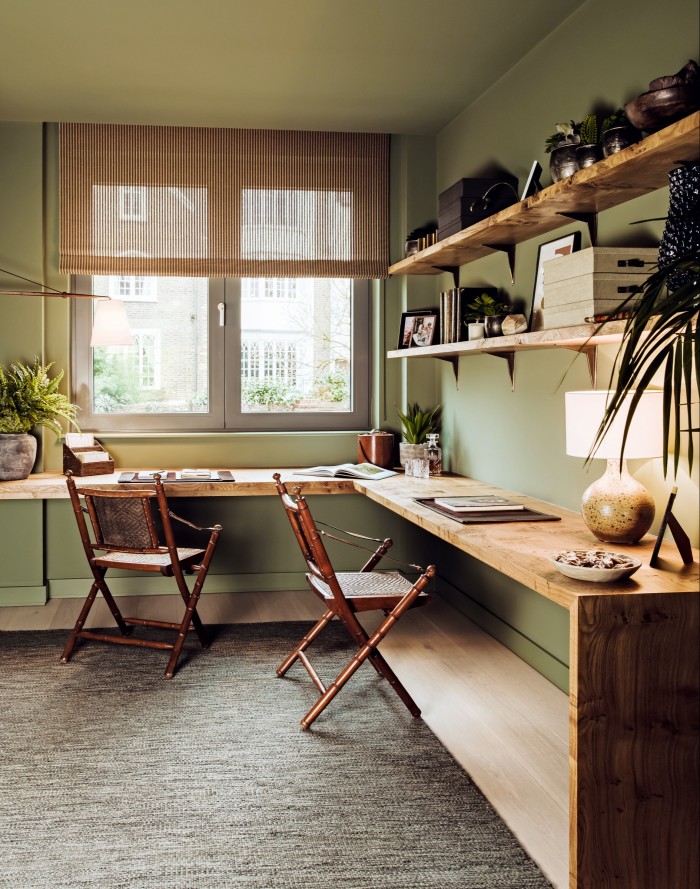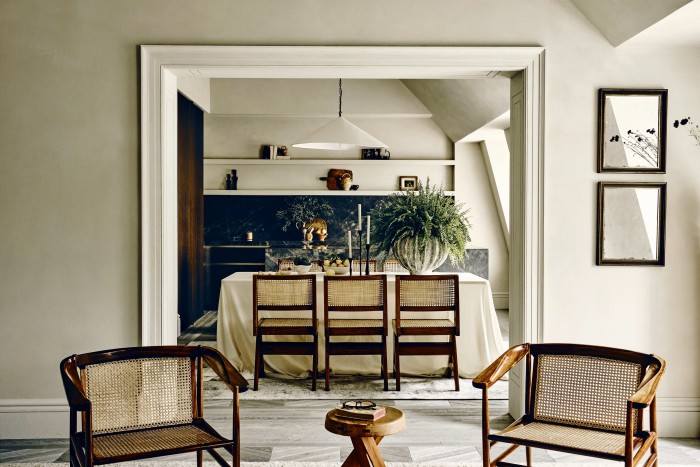It’s a jungle in here: the rise of the ‘biophilic’ home

Roula Khalaf, Editor of the FT, selects her favourite stories in this weekly newsletter.
Even before the term “biophilia” was popularised by Edward O Wilson, a Harvard biologist and conservationist who published a book of the same name in 1984, architects and designers had been using their skills to create harmony between nature and humans. Frank Lloyd Wright is a notable example, having used wood and stone to create striking architectural silhouettes deeply connected to the surrounding landscape.
While rapid urbanisation has left many of us feeling out of touch with nature, the tide is starting to turn. Stirred by political, climatic, social and pandemic strains, we are seeking spaces of refuge now more than ever before. And symbiotically, those who are designing our environments are re-evaluating old traditions to explore new approaches to harness nature’s power. One such practice is Span Architecture, established in New York in 1995 by Karen Stonely and Peter Pelsinski. “We’re about connecting people with nature through architecture and landscape, and this operates on a bunch of levels,” says Pelsinski. “There’s representational stuff, in that something will look like nature, but there’s the literal aspect: how do we use nature in a productive way to create spaces and reconnect people with it? That’s something we’re really interested in.”

August Moon is a rural waterfront property in New England’s Maine that, although contemporary in form, blends unobtrusively into the wooded landscape as it is clad in rich dark timber both inside and out. Over the past 15 years, the studio has also revived some of the property’s original buildings that once belonged to the former owner, the American socialite Brooke Astor. These include the glass-encased teahouse: an oasis surrounded by trees where prevailing breezes from the nearby water create natural ventilation to keep it cool. It’s not only beautiful, it’s biophilic design at its most functional.


Allowing nature to dictate the design of a space in a rural environment certainly feels more doable than in urban environments but WOHA, a Singapore-based architecture firm, has been researching and innovating new architectural solutions in this sphere for years. “Having populated the cities, there’s a sense that we’re not living in harmony with nature any more,” says co-founder Richard Hassell, who believes practising in Singapore has put them ahead of the game. The city-state began countering population density by fusing it with nature back in the 1960s, increasing the percentage of the island given over to green areas from 36 per cent to 47 per cent between 1986 and 2007. It is now dubbed “a city in a garden” and is home to the jaw-dropping Jewel Changi Airport featuring the world’s tallest indoor waterfall, the 40m HSBC Rain Vortex, as well as the giant, triffid-like Supertrees of its central Gardens by the Bay.
WOHA takes a holistic approach to green living. “We aren’t just interested in greenery from a human aspect – it’s not just a roof garden here or a green wall here. If I’m a bird, what do I need to inhabit this area? If I’m a squirrel, can I get up to this sky garden?” he says. The company has developed a rating system that monitors the performance of greenery on various levels, from the green plot ratio (measuring the amount of landscaped surfaces offered by a development) to the ecosystem contribution index (how they contribute to subsistence, wellbeing and livelihoods of all inhabitants), which encourages green buildings to attract animal life. “This approach is very much behind biophilia – it’s basically a love of diversity.”
Biophilic design does not only positively impact our environment, especially in urban areas, but our mindset too. It’s one of the few design theories backed by extensive research and evidence. In hospitals, for instance, it’s estimated that patients can recover eight-and-a-half times faster when looking out onto trees and greenery than, say, grey walls. And 22 per cent better when recuperating in natural light.



“It’s really about creating spaces that are more naturally restorative, recuperative and that help us to feel more positive and relaxed – we’re mimicking that state of calm we feel when in nature,” says Oliver Heath, founder of his eponymous Brighton design studio and an expert in biophilic design. There’s also the socio-psychological approach, which suggests that by connecting people with nature and natural elements you can put them in a more optimistic state of mind. The thinking is that when you’re in this state you’re more likely to form a connection with places as well as people within those spaces, “ultimately enhancing communities and allowing for better conversations”, says Heath.
Integrating nature into interior design is increasingly important for studios, even those such as London-based Albion Nord, responsible for dressing the interiors of the city’s new luxury residences at 80 Holland Park. “Almost every residential brief now includes the provision of an indoor-outdoor experience,” says creative director Camilla Clarke, explaining that the studio builds spaces around where natural light falls, and creates sight lines and focal points to highlight outdoor views. This is layered with textiles and materials such as rope-like sisal and Abacá (banana plant), as well as natural linens, wools and bouclé that add texture. “We’ll then bring in lots of indoor plants such as fiddle-leaf figs and fill big vases with dried eucalyptus,” adds Clarke, who says it’s all about engaging the senses.


The fact that green areas are increasingly eating up square footage in prime urban real estate signifies there is a value attached to the biophilic lifestyle. “Certainly our properties have always sold very well and I’m sure there’s a direct correlation,” says Edoardo Mapelli Mozzi of Banda Property, pointing to its latest project, a London penthouse that sits on a private garden square overlooking greenery. “We were trying to create a sanctuary inside a city,” he says of the residence. To enhance the natural feel throughout the apartment, Banda used hues of greens juxtaposed with detailing such as clay-based plaster, a 100 per cent natural material that also helps moderate moisture. “Your shoulders drop when you walk into this space,” he says.
Of course, we also want the same experience outside our homes: in the places where we shop and dine, for instance, and this is influencing commercial design. Mexico City-based designer Micaela De Bernardi sees plants as an integral part of her design narrative – and not just for visual effect. “They take in CO2 impacting the air we breathe and the humidity of our environment,” says De Bernardi, who is one of the creative minds behind the interiors at the plant-filled Damian restaurant in LA and Pujol, Enrique Olvera’s Mexico City go-to, where diners are greeted inside by a towering olive tree that stretches up into a translucent domed sky light. “Even in a less visible way, they emit particles that help relieve physical and mental stress.”
Heath points to the emphasis being put on biophilic design by big tech such as Apple, Google and Amazon – companies where it’s reasonable to assume they would only invest in design if there’s a return. “These principles are shown to improve worker concentration, engagement and cognitive ability but also to attract and retain staff in the ‘war for talent,’” he says, pointing to figures that show productivity can be increased by eight per cent and rates of wellbeing by 13 per cent.

Natural materials, windows and plants are easy and obvious additions in our everyday environments, but there’s growing interest in non-natural products too – especially in cases where nature can’t be welcomed indoors. “It’s fascinating how many manufacturers and technology providers are starting to mimic nature as a means to create more relaxing, stimulating and energising spaces,” says Heath. An important commission for his own studio was designing a recuperation room for autistic children at a school in Hackney. The children can’t always be in contact with fragile plants, so the design team had to rely on indirect references to nature. One of the solutions was to bring in natural-inspired wallpaper and create womb-like nooks and niches lined with sustainable Interface carpet tiles that soften the acoustics, so they could feel safe. “We tried to create a multisensory environment,” Heath explains.
“When we talk about sustainability it shouldn’t just be about the impact on the environment but also on people’s wellbeing,” he continues. “How can we use design as a means to restore the environment, people and the planet?” That is the question we all should be asking ourselves.
Beyond the cheese plant: Leaf Envy founder Beth Chapman spotlights eight houseplants to refresh your foliage

Anthurium Clarinervium
A petite plant with velvety leaves that look gorgeously luxe.

Alocasia Zebrina
Unusually, it’s the zebra-patterned stems that make this plant stand out.

Red Heart Syngonium
Dusty-pink crumpled leaves have a subtle botanical romance.

Pink Nanouk
Much loved for its shimmery leaves with punky shocks of pink.

Philodendron Micans
New leaves unfurl red-purple before turning velvety green and trailing down.

Caladium White Queen
A delicate beauty with pale, paper-thin leaves and pink veins.

Macodes Jewel Orchid
These dark-green leaves have neon lightning veins that catch the light.

Calathea White Fusion
A fun, unruly ruffle of marbled leaves with a pale-purple underbelly.
Comments